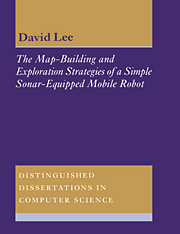 The Map-Building and Exploration Strategies of a Simple Sonar-Equipped Mobile Robot
The Map-Building and Exploration Strategies of a Simple Sonar-Equipped Mobile Robot Book contents
- Frontmatter
- Contents
- Preface
- 1 Question, Context and Method
- I Starting Points
- II System Components
- III Experiments
- 11 Experimental Evaluation
- 12 Wall-Following
- 13 The Results of Localisation
- 14 Supervised Wall-Following
- 15 Can a Human Do Any Better?
- 16 Longest Lines of Sight
- 17 Free Space Boundaries
- 18 Summary of Experimental Results
- 19 Conclusions
- 20 Directions for Further Research
- Appendix A The Feature-Map Data Structure
- Appendix B Test Rooms
- Appendix C Finding the Best-Fit Line
- Appendix D ARNE's Standard Dialogue
- Bibliography
- Index
17 - Free Space Boundaries
Published online by Cambridge University Press: 05 March 2012
- Frontmatter
- Contents
- Preface
- 1 Question, Context and Method
- I Starting Points
- II System Components
- III Experiments
- 11 Experimental Evaluation
- 12 Wall-Following
- 13 The Results of Localisation
- 14 Supervised Wall-Following
- 15 Can a Human Do Any Better?
- 16 Longest Lines of Sight
- 17 Free Space Boundaries
- 18 Summary of Experimental Results
- 19 Conclusions
- 20 Directions for Further Research
- Appendix A The Feature-Map Data Structure
- Appendix B Test Rooms
- Appendix C Finding the Best-Fit Line
- Appendix D ARNE's Standard Dialogue
- Bibliography
- Index
Summary
17.1 Motivation
The exploration strategies presented so far in Part III of this thesis have differed in the extent to which the map has been used to control the navigational choices. Wall-Following (Chapter 12) and Longest Lines (Chapter 16) were both totally reactive, not using the map at all. Supervised Wall-Following (Chapter 14) used the map to detect circumstances in which wall following was becoming ineffective. Chapter 15 showed the results that could be obtained when a human operator used the map to guide the exploration. This chapter will present an exploration strategy in which ARNE's decisions are driven primarily by the information present in the partially-formed map.
The implementation described in Section 17.2 builds on the ideas presented in Section 4.2; ARNE approaches the interesting regions of the environment. The central issue is, of course, the definition of ‘interesting’. The definition adopted here focuses on the edges of free space, the regions in which free cells are next to unknown cells.
Section 17.3 presents the results of experiments to evaluate this strategy and Section 17.4 summarises the results.
17.2 Implementation
The first step in this implementation was to identify the cells on the free-space map which were to be examined. The decision was made that ARNE should approach unknown regions but, to avoid collisions or panic stops, it should not actually enter unknown regions. The interesting cells are therefore those on the boundary between free and unknown space.
- Type
- Chapter
- Information
- The Map-Building and Exploration Strategies of a Simple Sonar-Equipped Mobile RobotAn Experimental, Quantitative Evaluation, pp. 173 - 186Publisher: Cambridge University PressPrint publication year: 1996


